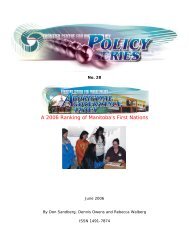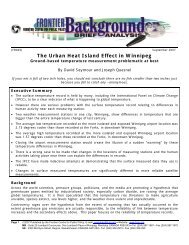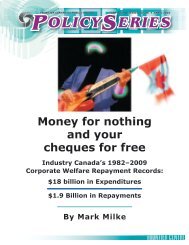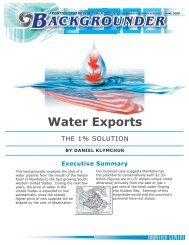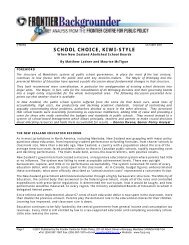Powerpoint slides in pdf format
You also want an ePaper? Increase the reach of your titles
YUMPU automatically turns print PDFs into web optimized ePapers that Google loves.
Economic Prosperity and<br />
the Size of Government <strong>in</strong> Manitoba<br />
1<br />
Niels Veldhuis<br />
Senior Research Economist<br />
The Fraser Institute<br />
www.fraser<strong>in</strong>stitute.ca
Presentation Outl<strong>in</strong>e<br />
2<br />
‣ Economic Prosperity <strong>in</strong> Manitoba<br />
‣ Size of Government<br />
‣What does the research say?<br />
‣How Big is Manitoba<br />
Government?<br />
‣ Taxes
Economic Prosperity:<br />
Manitoba <strong>in</strong> the Canadian Context
Gross Domestic Product (GDP)<br />
Per Capita (2003)<br />
4<br />
45,000<br />
40,000<br />
1997 CDN Dollars<br />
35,000<br />
30,000<br />
25,000<br />
20,000<br />
15,000<br />
10,000<br />
5,000<br />
0<br />
AB ON SK BC QC NF MB NB NS PEI
Disposable Income Per Capita<br />
(2003)<br />
5<br />
25,000<br />
20,000<br />
1997 CDN Dollars<br />
15,000<br />
10,000<br />
5,000<br />
0<br />
AB ON BC QC MB NS SK NB NF PE
Avg Total Employment Growth<br />
(2000-2004)<br />
2004)<br />
6<br />
3<br />
2.5<br />
2<br />
Percent<br />
1.5<br />
1<br />
0.5<br />
0<br />
AB ON QC PE NS BC NB NF MB SK
Avg Private Employment Growth<br />
(2000-2004)<br />
2004)<br />
7<br />
3<br />
2.5<br />
2<br />
Percent<br />
1.5<br />
1<br />
0.5<br />
0<br />
AB NF ON PE QC BC NB NS SK MB
Unemployment Rate<br />
(2000-2004)<br />
2004)<br />
8<br />
18<br />
16<br />
14<br />
12<br />
Percent<br />
10<br />
8<br />
6<br />
4<br />
2<br />
0<br />
AB MB SK ON BC QC NS NB PE NF
Duration of Unemployment<br />
(2000-2004)<br />
2004)<br />
9<br />
25<br />
20<br />
Percent<br />
15<br />
10<br />
5<br />
0<br />
AB PE MB NB SK NS ON BC NF QC
Net Migration With<strong>in</strong> Canada<br />
(1996-2001)<br />
10<br />
6<br />
Percent of Base Population<br />
4<br />
2<br />
0<br />
-2<br />
-4<br />
-6<br />
-8<br />
AB ON PEI NS BC QC NB MB SK NF<br />
* Between 1996 and 2001, 21,041 people left Manitoba.
Net Bus<strong>in</strong>ess Capital Formation<br />
(1994-2003)<br />
11<br />
50,000<br />
45,000<br />
40,000<br />
35,000<br />
30,000<br />
25,000<br />
20,000<br />
15,000<br />
10,000<br />
5,000<br />
0<br />
AB NF BC NS ON PE MB QC SK NB
Restra<strong>in</strong>ts to Prosperity<br />
12<br />
‣ Size of Government<br />
‣ Taxation: Burden of<br />
Government
Size of Government<br />
13
Size of Government &<br />
Economic Growth<br />
14<br />
‣ Grossman (1988): negative relationship between<br />
growth <strong>in</strong> government and rate of economic growth<br />
‣ Grier & Tullock (1989): Government had significant<br />
negative effect on economic growth.<br />
‣ Peden & Bradley (1989): government negatively<br />
affects economic base and rate of economic<br />
growth.<br />
‣ Vedder (1993): Increased government spend<strong>in</strong>g<br />
leads to lower rates of economic growth.
Size of Government &<br />
Economic Growth<br />
15<br />
‣ Vedder & Gallaway (1998): large transfers have<br />
negative growth effects, moderate reductions <strong>in</strong><br />
government resulted <strong>in</strong> <strong>in</strong>creased economic growth,<br />
and that the marg<strong>in</strong>al effect of government is<br />
negative. Recommended reduc<strong>in</strong>g government to<br />
17.4% of GDP.<br />
‣ Barro (1991): Consumption spend<strong>in</strong>g by<br />
government did not enhance productivity but did<br />
result <strong>in</strong> lower sav<strong>in</strong>gs and growth rates.
Size of Government &<br />
Economic Growth<br />
16<br />
‣Folster<br />
& Henrekson (2001): 10% <strong>in</strong>crease <strong>in</strong><br />
government spend<strong>in</strong>g reduces GDP growth by 0.7 to 0.8<br />
percentage po<strong>in</strong>ts.<br />
‣Alberto<br />
Ales<strong>in</strong>a (2002): <strong>in</strong>creases <strong>in</strong> government<br />
spend<strong>in</strong>g as a percent of GDP result <strong>in</strong> significantly lower<br />
<strong>in</strong>vestment as a percentage of GDP.<br />
‣ Sala-I-Mart<strong>in</strong> (2004): Government consumption as a<br />
share of GDP and public <strong>in</strong>vestment as a share of GDP<br />
are negatively related to economic growth
Optimal Size of Government<br />
17<br />
‣ Scully (1991): Optimal tax burden for 103 countries<br />
was 19.3 GDP.<br />
‣ Peden (1991): Optimal size of government = 17% GDP.<br />
‣ Scully (1995): Optimal US tax burden = 21.5% GDP.<br />
‣ Grubel & Chao (1999): Optimal Cdn Burden = 33%<br />
GDP.<br />
‣ Mackness (1999): Optimal Cdn size of government<br />
equaled roughly 20 to 30% of GDP.
Size of Government:<br />
(Prov<strong>in</strong>cial & Municipal Only)<br />
18<br />
35<br />
30<br />
Percent of GDP<br />
25<br />
20<br />
15<br />
10<br />
5<br />
0<br />
AB ON BC NS SK NF MB NB QC PE
Size of Government:<br />
(Federal, Prov<strong>in</strong>cial & Municipal)<br />
19<br />
70<br />
60<br />
Percent of GDP<br />
50<br />
40<br />
30<br />
20<br />
10<br />
0<br />
AB ON BC SK QC MB NF NB NS PE
Size of Prov<strong>in</strong>cial-Local Government<br />
20<br />
percent of GDP<br />
40.0<br />
35.0<br />
30.0<br />
25.0<br />
20.0<br />
15.0<br />
10.0<br />
5.0<br />
0.0<br />
1989/90<br />
1990/91<br />
1991/92<br />
Source: Statistics Canada, F<strong>in</strong>ancial Management System (2003).<br />
1992/93<br />
1993/94<br />
1994/95<br />
1995/96<br />
1996/97<br />
1997/98<br />
1998/99<br />
1999/00<br />
2000/01<br />
2001/02<br />
2002/03<br />
2003/04
Size of Prov<strong>in</strong>cial-Local Government<br />
21<br />
percent of GDP<br />
40.0<br />
35.0<br />
30.0<br />
25.0<br />
20.0<br />
15.0<br />
10.0<br />
5.0<br />
0.0<br />
1989/90<br />
1990/91<br />
1991/92<br />
1992/93<br />
1993/94<br />
1994/95<br />
1995/96<br />
1996/97<br />
1997/98<br />
1998/99<br />
1999/00<br />
2000/01<br />
2001/02<br />
2002/03<br />
2003/04<br />
ON MB SK AB BC
MB Government Spend<strong>in</strong>g<br />
(Inflation-Adjusted)<br />
22<br />
Millions<br />
9,500<br />
9,000<br />
8,500<br />
8,000<br />
7,500<br />
7,000<br />
6,500<br />
6,000<br />
5,500<br />
5,000<br />
1990/91<br />
1991/92<br />
1992/93<br />
Source: Statistics Canada, F<strong>in</strong>ancial Management System (2003).<br />
1993/94<br />
1994/95<br />
1995/96<br />
1996/97<br />
1997/98<br />
1998/99<br />
1999/00<br />
2000/01<br />
2001/02<br />
2002/03<br />
2003/04
MB Government Spend<strong>in</strong>g (Real)<br />
(2005 Budget Data)<br />
23<br />
8,500<br />
8,000<br />
Millions of Dollars<br />
7,500<br />
7,000<br />
6,500<br />
6,000<br />
5,500<br />
5,000<br />
2002/03<br />
2003/04<br />
2004/05<br />
2005/06<br />
2006/07
Taxation: Burden of Government<br />
24
Top Marg<strong>in</strong>al P.I.T. Rates (2004)<br />
Prov<strong>in</strong>cial-Only<br />
25<br />
20<br />
15<br />
Percent<br />
10<br />
5<br />
0<br />
AB BC SK MB ON NB PE QC NS NF
General C.I.T. Rates (2004)<br />
Prov<strong>in</strong>cial-Only<br />
26<br />
Percent<br />
18<br />
16<br />
14<br />
12<br />
10<br />
8<br />
6<br />
4<br />
2<br />
0<br />
AB NB BC NF ON MB PE NS QC SK
Corporate Capital Taxes (2003/04)<br />
As a Percent of Own-Source Revenues<br />
27<br />
Percent<br />
6<br />
5<br />
4<br />
3<br />
2<br />
1<br />
0<br />
AB NF PE BC NB NS ON MB QC SK
Sales Tax Rates (2004)<br />
Prov<strong>in</strong>cial-Only<br />
28<br />
10<br />
8<br />
Percent<br />
6<br />
4<br />
2<br />
0<br />
AB BC SK MB QC NF NS NB ON PE
Effective Corporate Tax Rates (2004)<br />
29<br />
Percent<br />
40<br />
35<br />
30<br />
25<br />
20<br />
15<br />
10<br />
5<br />
0<br />
NF NB AB PEI NS QC BC ON MB SK
Conclusion & Recommendations<br />
30<br />
‣ Spend<strong>in</strong>g restra<strong>in</strong>t / reductions with the aim of<br />
reduc<strong>in</strong>g government to 20%-30% of GDP<br />
‣ Tax relief and reform:<br />
• Focus on <strong>in</strong>centive based tax relief<br />
• At m<strong>in</strong>imum br<strong>in</strong>g taxes rate <strong>in</strong> l<strong>in</strong>e with<br />
Canada’s more prosperous prov<strong>in</strong>ces
Questions & Answers…<br />
31




